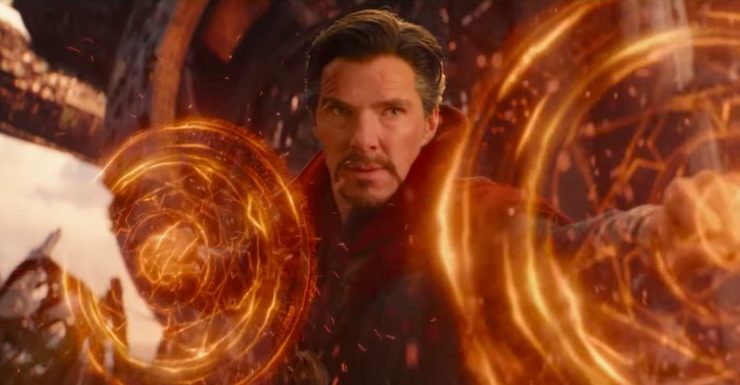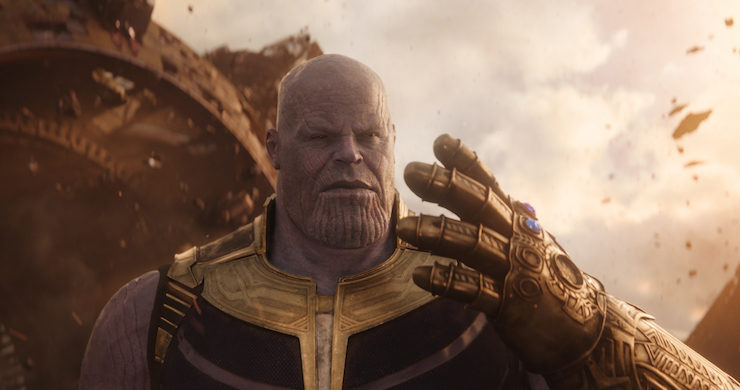Full spoilers for Avengers: Infinity War ahead!
Doctor Strange spends nearly a year watching the world end.
No really, so many spoilers—turn back now!
Let’s be more specific: After arriving on Thanos’ home planet of Titan and learning the scope of The Mad Purple One’s plan, Doctor Strange goes off to float in a corner. When Tony finally notices Strange flickering in and out of reality, the Doctor gives him the explanation: he’s been analyzing potential futures to discover how to defeat Thanos. He checked 14,000,605 timelines (he counted!) and found only one where the result is to his liking.
Being generous with the capabilities of Strange’s human, linear-time-perceiving brain, let’s say he processes potential outcomes continuously: sweeping through a near-future scope (How does he choose? Monte Carlo simulation? Some deterministic algorithm? Testing actions to see results? He doesn’t exactly have time to tell us his methodology), seeing destruction everywhere, passing to the next one. At an average rate of n seconds per timeline, this takes a linear human-time analysis (to 6 decimal places) of:
14,000,605 timelines * (n sec / timeline) * (1 hr / 3600 sec) * (1 day / 24 hr) = 162.044039 n days.
Regardless how long it takes the Simulator Supreme to verify that the single “win” outcome is truly a win, the 14,000,604 negative trials take (at a heroically fast rate of n = 2 seconds each) just over 324 days. That’s almost 11 months. Presumably without rest or other (non-magical) physical replenishment.
Strange’s analysis is done with experience; we’ve seen him plan, and execute, time loops that resulted in his repeated death before. He could have kept scanning, too. Because as far as examining many worlds is concerned, 14 million is just a drop in the possibility bucket. Strange could attempt, but not possibly succeed, in being thorough in his sampling of the vast multidimensional space of potential futures, since there are so many variations, so many unknown unknowns. It likely took him most of his processing time just to find that one possible future of success, and that one success did not include him surviving, let alone holding the Time Stone.
This is the situation machine learning algorithms have to deal with: a large amount of data, with often a simple check: what’s the result? In Strange’s case, this was checking a scenario and asking, “Do we live?” 14,000,604 out of 14,000,605 times, the answer was no.
Which means he watched at least half of the universe die, in different configurations, 14,000,604 times.
For at least 11 months straight.
Strange reports his findings to Iron Man and, regardless of the snark between Strange and Stark, they trust each other’s work; they’re both highly trained technicians. As an engineer, Tony is no stranger to trial and error, and appreciates the grueling, repetitive, necessary nature of Strange’s task.
The fact that only one of these 14 million worked must mean there’s some fluke, some completely non-intuitive confluence of just the right factors, to make that one timeline special. Otherwise, there would have been an entire series of them, with small modifications, that all used the same basic parameters. Therefore, if Strange has worked this one plan out, and he’s not there to see it through to completion or communicate it to Stark, everything might be left up to luck again once he’s gone.
Stark and Strange know enough game theory to know that they both know Strange knows what he’s doing. Strange pointedly says, “YouWe’re in the endgame now,” in response to Tony’s slack-jawed stare at the relinquishing of the Time Stone. There’s only one good reason: Strange knows what that just-right permutation is, and it involves him being dead before it’s all over.
The real question now is, did Strange set any hidden variables, any unseen dominoes, up during his analysis? What caused his Infinite Hail Mary pass? What did he do to ensure Tony’s endgame? And will we flash back to find out next time?
Avengers 4: A Strange Year?
Suppose Michael Carlisle (@docintangible) is a mathematician and writer living in New York.











